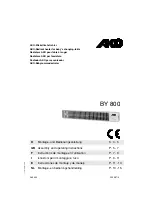
9
HARD WATER
Where hard water conditions exist, water softening or the threshold
type of water treatment is recommended. This will protect the
dishwashers, coffee urns, water heaters, water piping and other
equipment.
See MAINTENANCE section for details of tank cleanout
procedure.
AIR REQUIREMENTS
REFER TO THE CURRENT EDITION OF THE “NATIONAL FUEL
GAS CODE” ANSI Z223.1/NFPA 54.
WARNING
KEEP APPLIANCE AREA CLEAR AND FREE OF COMBUSTIBLE
MATERIALS, GASOLINE AND OTHER FLAMMABLES, VAPORS
AND LIQUIDS.
DO NOT OBSTRUCT THE FLOW OF COMBUSTION OR
VENTILATING AIR.
WARNING
FOR SAFE OPERATION PROVIDE ADEQUATE AIR FOR
COMBUSTION AND VENTILATION. AN INSUFFICIENT SUPPLY
OF AIR WILL CAUSE RECIRCULATION OF COMBUSTION
PRODUCTS RESULTING IN AIR CONTAMINATION THAT
MAY BE HAZARDOUS TO LIFE. SUCH A CONDITION OFTEN
WILL RESULT IN A YELLOW, LUMINOUS BURNER FLAME,
CAUSING CARBONING OR SOOTING OF THE COMBUSTION
CHAMBER, BURNERS AND FLUE TUBES AND CREATES A
RISK OF ASPHYXIATION.
Where an exhaust fan is supplied in the same room with
a heater, sufficient openings for air must be provided in
the walls.
UNDERSIZED OPENINGS WILL CAUSE AIR TO
BE DRAWN INTO THE ROOM THROUGH THE CHIMNEY,
CAUSING POOR COMBUSTION. SOOTING MAY RESULT IN
SERIOUS DAMAGE TO THE HEATER AND RISK OF FIRE OR
EXPLOSION.
UNCONFINED SPACE
In buildings of conventional frame, brick, or stone construction,
unconfined spaces may provide adequate air for combustion,
ventilation and draft hood dilution.
If the unconfined space is within a building of tight construction
(buildings using the following construction: weather stripping,
heavy insulation, caulking, vapor barrier, etc.), air for combustion,
ventilation and draft hood dilution must be obtained from outdoors.
The installation instructions for confined spaces in tightly
constructed buildings must be followed to ensure adequate air
supply.
CONFINED SPACE
When drawing combustion and dilution air from inside a
conventionally constructed building to a confined space, such a
space shall be provided with two permanent openings, ONE IN OR
WITHIN 12 INCHES (30.5cm) OF THE ENCLOSURE TOP AND
ONE IN OR WITHIN 12 INCHES (30.5cm) OF THE ENCLOSURE
BOTTOM. Each opening shall have a free area of at least one
square inch per 1000 Btuh (2,225mm
2
/kW) of the total input of all
appliances in the enclosure, but not less than 100 square inches
(645 square cm).
If the confined space is within a building of tight construction,
air for combustion, ventilation, and draft hood dilution must be
obtained from outdoors. When directly communicating with the
outdoors or communicating with the outdoors through vertical
ducts, two permanent openings, located in the above manner,
shall be provided. Each opening shall have a free area of not
less than one square inch per 4000 Btuh (8,900mm
2
/kW) of the
total input of all appliances in the enclosure. If horizontal ducts
are used, each opening shall have a free area of not less than
one square inch per 2000 Btuh (4,450mm
2
/kW) of the total input
of all appliances in the enclosure.
VENT REDUCER
The SBD 250, 251, and 275 models are shipped with an 8” to
6” diameter flue outlet adapter. Each adapter fits on top of the
installed flue damper. Use only vent reducers supplied with the
unit. The venting must comply with the NATIONAL FUEL GAS
CODE, ANSI Z223.1/NFPA 54.
FIGURE 7
ILLUSTRATION OF MINIMUM COMBUSTIBLE CLEARANCES IN AN ALCOVE
FIGURE 6
Summary of Contents for SBD100199*
Page 35: ...35...










































